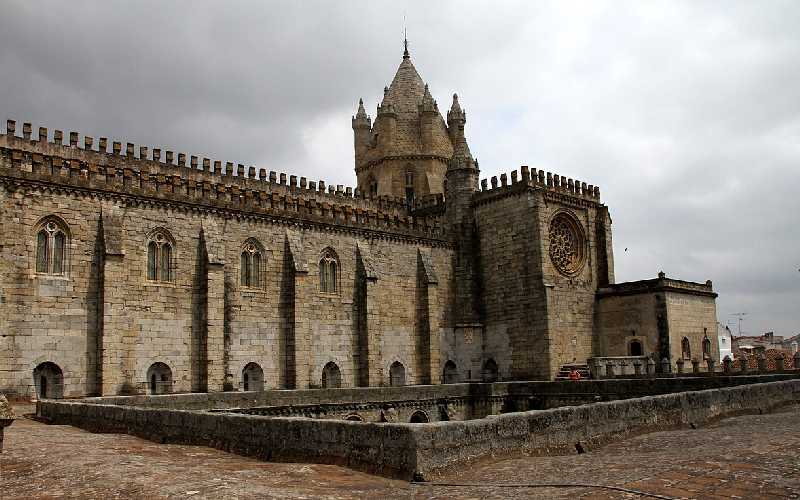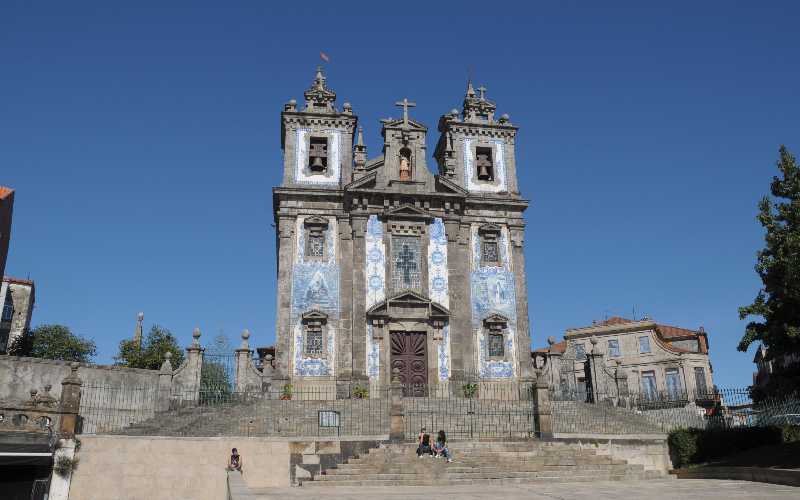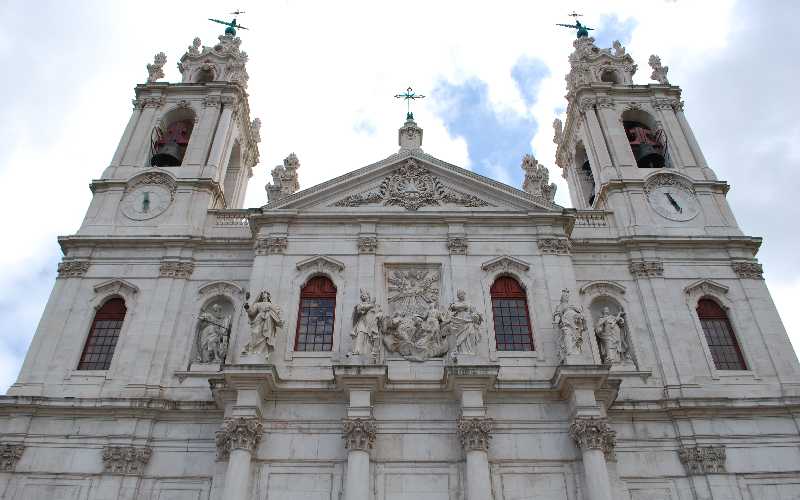The biggest majority of the Portuguese public are of the Roman Catholic faith and this can be demonstrated throughout Portugal with the vast array of churches, chapels, cathedrals, and monasteries dedicated to the faith.
For many, these buildings aren’t just a symbol of their religion but also a huge part of their culture.
Here is our list of some of these incredible religious buildings throughout Portugal:
Mosteiro de Jeronimos

This former monastery is situated near the Tagus river, in the Belém area of Lisbon. This monastery was secularised in 1833 and is now run by a charitable organisation. It has been a world heritage site since 1983 and it’s easy to see why with its stunning church, fountains and two-storey cloister. It’s a fine example of the Manueline style, with its many ornate and complex structures. This monastery was under the order of Saint Jerome who was famed for looking after sailors and explorers and aspects of this is demonstrated within the architecture with maritime elements to be spotted throughout.
The south entrance features an incredible 32-metre high ornate portal. Inside the church, is the tomb of Luis de Camỡes a famous Portuguese poet!
This monastery is situated West of central Lisbon and can be easily accessed by hopping on the number 15 tram from Lisbon to Belem. It is open from 10 am to 6:30 pm June to September and until 5:30 pm from October to May. For adults, it costs 10 euros and for children, it is 5 euros.
Se Cathedral Lisbon
This is the oldest church in the city, built in 1147! It has been well utilised by the Portuguese elite over the years and many of them have been baptised and married there.
It is a perfect demonstration of gothic architecture, with its arches, its vaulted ceilings and of course, its cloister! It also has rather sold sturdy walls and two clock towers.
The cloister to the rear has actually been partially excavated in order to reveal the remains of a mosque that the cathedral was built upon.
The cathedral is situated on the main road from Baixa to Alfama, with the nearest metro being Rossio. However, I’d personally travel via the yellow tram – route 28 – for the most spectacularly picturesque journey and the tram conveniently stops right in front of the cathedral.
The cathedral is open from 7 am to 7 pm every day with no entry fee and visitors are asked to dress appropriately and respectably, given this is a religious building.
The cloisters are open from 10 am to 5 pm and cost €2 entry for adults and €1 for children/students/seniors.
Evora Se Cathedral

In the highest spot of the historical city centre, in the beautiful city of Evora lies this cathedral. It is the oldest and (to most) the most important of the local monuments. It was built between 1186 and 1250 and is completely made of granite.
It demonstrates a beautiful transition from Romantic to Gothic styles. It features two towers, the south bell tower ringing out the time to the whole city! There is also a beautiful dome on top, which can be seen from miles around.
Inside, you have stunning gothic arches, gilded wood, a cloister, statues and a pipe organ heralding from the Renaissance period.
In the building adjoining the cathedral, there is a religious art museum, containing many interesting religious artefacts and is also well worth a visit.
Both are open Tuesday to Sunday from 9 am to 5 pm, with the last entry being 30 minutes prior to closing.
Prices range from 2 euros to 4.50 euros, depending on if you’re just wanting to view the cathedral, or the cathedral and cloisters and also if you wish to add a visit to the museum on too.
Bom Jesus do Monte Shrine – Braga
The selling point of this church is the incredible 116 metres tall monumental Baroque staircase leading to it! This is officially known as Portugal’s most photographed church and it’s not difficult to understand why!
The staircase is highly ornamental and features several landings with grottoes, fountains and statues all depicting the life of Jesus. These landings also offer good breathing spots for a break if you decide to climb your way to the church at the top! This is a popular Catholic pilgrimage site and as such, once you get nearer to the top you may see some of the most devoted to their faith, climbing the last few levels on their knees! This is to mimic the pain that Jesus himself would have felt prior to his crucifixion.
For those unable to manage all the stairs to the top, there is a lift that will take you from the base of the hill to the church at the top, so no one has to miss out. The church does seem a bit stark in decoration in comparison to the stairs leading to it but the views from the church, out over Braga are absolutely incredible – particularly at sunset and the church is an early demonstration of neoclassical design.
Travel wise, you can take the local Braga bus number 2, from the centre out to the base of the stairs and this runs every 30 minutes Monday to Saturday and hourly on a Sunday.
Santo Ildefonso – Porto

If you are looking for a church with a fantastic example of those famous Portuguese blue and white tiles (azulejos) then the outside of this church will definitely appeal to you!
Designed by Italian architect Nicolau Nasoni, it features two bell towers, intricate Baroque style carvings and has a stunning tube organ that has been in the building since 1811!
This church is completely free to enter for everyone. It is open on Monday afternoons from 3 pm to 6:30 pm. Then from Tuesday to Saturday, it is open from 9 am to 12 pm, then 3 pm to 6:30 pm. On Sundays, it is open from 9 am to 1 pm and then from 6 pm to 8 pm. The last entry on each day is 30 minutes prior to closing.
Sao Roque Lisbon
From the outside, this building looks rather bland and many walk past. Inside, however, is one of the most decorative, ornate, beautiful churches that Portugal has to offer!
It features an intricately painted ceiling, glazed tiles, Florentine mosaics and despite all this beauty, it also offers peace and tranquillity as it is so often overlooked due to its boring exterior.
Another selling point to visiting here is the chapel of St John the baptist. This chapel was actually originally erected in Rome, so it could be blessed by Pope Benedict XIV, before then being dismantled and brought to Lisbon!
There is also an adjoining museum with a variety of religious artefacts.
The closest metro is Baixo – Chiado but be aware there is a bit of a steep walk to reach the church!
There is no entrance fee to enter the church and it is open to the public from 10 am to 6 pm (9 pm on Thursdays) every day. If you wish to also visit the museum while there that would cost you €2.50.
Batalha Monastery
Built to commemorate the victory of the Portuguese over the Castilians at the battle of Aljuburrota in 1385, this monastery has a variety of gothic features to see – especially the royal cloister.
The main thing that will take your breath away when you enter, is the height! But also, the stunning stained glass windows. In the centre of the founders chapel, you will find the medieval tombs of Dom Joâol and his wife, Queen Phillippa of Lancaster. Their sons are also in tombs that lay within the chapel walls!
The main church, with its stunning 8 point, star-shaped lantern in the centre of the ceiling, is free to visit. The chapel and the cloister cost €7.50 for entry (with discounts available fro children/students/seniors).
Convent of Christ – Tomar
This former Catholic convent is set atop a hill within the interior of the walls of the Castle of the Knights Temple.
The main selling points here are the Templar Charola (rotunda), featuring 2 heights, eight pillars and sixteen sides. Inside it features beautiful artwork from a variety of famous Portuguese artists as well as various religious sculptures.
There are also 4 cloisters definitely worth viewing and the chapter window – an incredibly ornate, sculpted window. It demonstrates a variety of maritime artefacts and discoveries and is a stunning example of Manueline architecture.
This convent is open from 9 am to 5:30 pm, October to May and from 9 am to 6:30 pm, June to September. The last entry is 30 minutes prior to closing, though I’d recommend allowing yourself more time to enjoy the intricacies of the design if possible.
Basilica de Estrela

This beautiful basilica and convent in Lisbon were the first in the world to be dedicated to the Sacred Heart of Jesus. Queen Maria I of Portugal ordered it to be built, following the arrival of her son.
It is a stunning example of late Baroque and neoclassical styles, with a giant dome – that you can actually climb up, to get some stunning views! It also features some stunning statues of saints, twin bell towers and the most beautiful grey, pink, and yellow tiles on the floors and walls, making intricate geometric patterns.
Also popular with visitors is the famous nativity scene which has more than 500 cork and terracotta figures!
Trams 25 and 28 travel right by this church and it is open from 8:45 am to 8 pm every day, with free entry.
Basilica de Nossa Senhora do Rosario de Fatima
This huge white basilica in Fatima holds the tombs of three children – Lucia, Jacinta and Francisco who were believed to have had the first of six apparitions of the Virgin Mary that were seen here in 1917.
The building began in 1928 and was completed in 1953 and as such does not offer the same sort of architectural styles so often seen within many other religious buildings throughout Portugal. However, there is a 65-metre tall church spire, upon which sits a huge bronze crown that lights up at night.
There are also stunning stained glass windows, depicting the events of the apparitions of the Virgin Mary, as well as the 15 marble alters inside.
The church is only a short walk from Fatima bus station
Santuario do Senhor Jesus da Pedra – Obidos
This church rises up from a site just outside of the ancient town walls. It was built in 1750 in a memorandum to King João V.
It is a beautiful example of Baroque architecture, most interesting, however, is the hexagonal floor plan – an original design for its time!
There are three chapels inside, the main chapel dedicated to Calvery and two side chapels dedicated to Our Lady of Conception and the Death of St. Joseph. All three contain beautiful canvasses by well-known Portuguese artists.
Throughout there are a variety of examples of stunning marble, beautiful furniture and religious artwork as well as an impressive stone crucifix which can now be seen standing at the altar.
As demonstrated, religion plays a huge part in the national culture of Portugal.
Given that Roman Catholicism has, for a long time, been the leading religion within the country, there are a plethora of churches, cathedrals etc, for people to show their dedication to their religion.
Regardless of where in Portugal you are thinking of visiting, there will be some amazing religious buildings to explore!
We hope the above list gives you a great starting point and may even provide you with buildings and locations within Portugal, that you wouldn’t have otherwise considered!
If you enjoyed this article you might also like to read about Churches of Porto


2 thoughts on “Churches of Portugal”